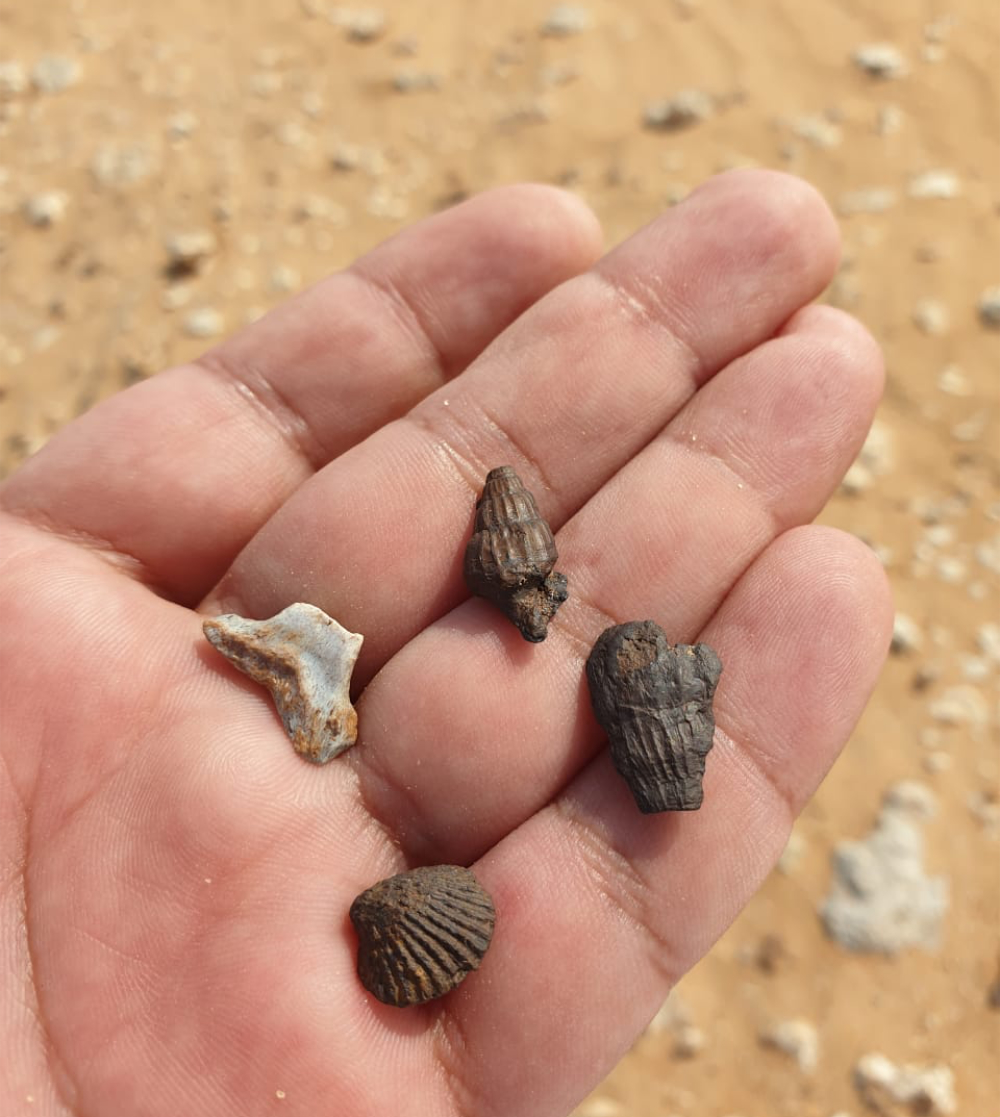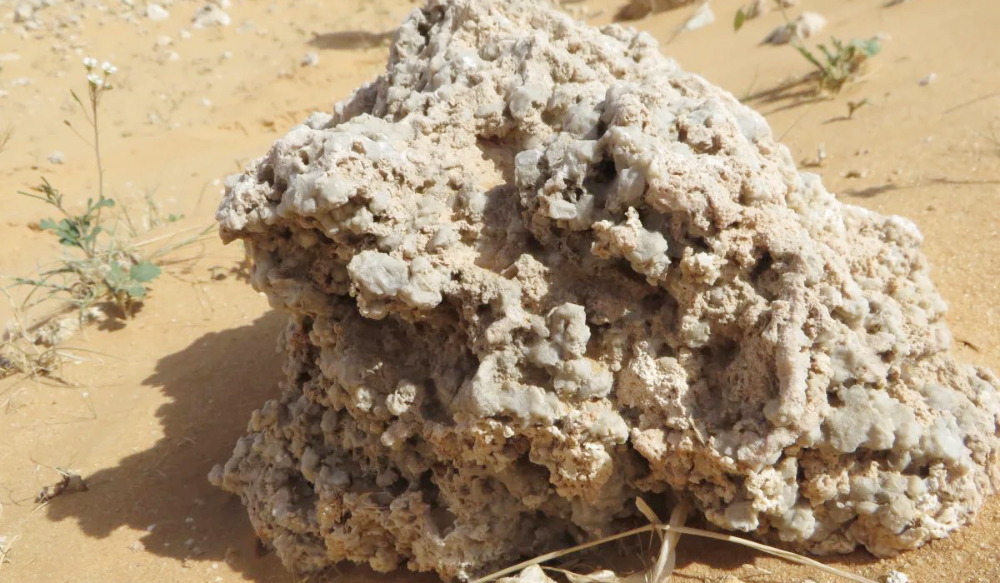JEDDAH: The Khurais desert lies halfway between Hufof and Riyadh. Beds of solid sedimentary rock from the Eocene epoch and earlier eras dip gently toward the east. These beds are well exposed for two main reasons — lack of vegetation and extreme wind erosion — and the fossils and geographical gems found here tell the secrets of millions of years ago.
Arab News had a deep dive interview with Iyad Zalmout, the technical adviser of the Geology and Paleontology Survey and Exploration Center at the Saudi Geological Survey. For the survey’s program on the Khurais area, the desert is dubbed “Shark Teeth Trail” due to the shark teeth, shells and bones of sea creatures found on its surface.
The fossils indicate that the Khurais area, scientifically known as the “Dammam Formation,” was immersed in water a long time ago.

The Dammam Formation is loaded with the fossilized remains of marine creatures that tell the story of a different time. (Supplied)
Environmentally and geologically speaking, Zalmout said that by looking at the fossils of the Dammam Formation “we may be able to assemble an image of the depositional environment and marine ecology of the Tethyan Sea in Saudi Arabia 45 million years ago.”
He said: “The main rock unit in question here is called the Dammam Formation, and it was deposited and formed 46 million years ago during the dominance of the Tethyan Sea, a stage of the geological time called Lutetian or part of the Middle Eocene.
Only one scientific note was published on the fauna and flora of the Eocene Dammam Formation ... we are hoping that more can be done in terms of research and conservation on the site.
Iyad Zalmout, Paleontology technical adviser, Saudi Geological Survey
“The sediments of this formation are very well exposed in shallow depressions, domes, also along small hills and buttes.”
Since the Eocene era, the whole region east of the Arabian Shield has undergone many changes through erosion, deposition, deformation, uplifting, subsidence and rise and fall of sea level. All of that has contributed to changes in the climate and surrounding environments and landscape.
For example, during the Middle Eocene, shallow warm marine waters covered most of the eastern and northern region in the Arabian Peninsula, resulting in the deposit of carbonate rocks: 30 million years later during the Middle Miocene the same area experienced erosion due to rivers, lakes and deltas that were present in some places. The area has now transformed into a desert due to the influence of sand migration and arid climate for the past 20,000 years.

The Dammam Formation is loaded with the fossilized remains of marine creatures that tell the story of a different time. (Supplied)
Dammam Formation
The Dammam Formation is a sedimentary region that is made up of carbonate rocks, shales and marl that were deposited during a highstand sea level when most of the Arabian landmass was part of East Africa before the rifting of the Red Sea.
The formation is mostly restricted to the eastern side of the Arabian Peninsula on the surface and in the subsurface. It is exposed in Saudi Arabia in Khurais, Dammam, Alkhobar and under the aeolian deposits on the eastern side of the Empty Quarter. It is also visible in Bahrain, Qatar, Oman and the UAE.
HIGHLIGHTS
• The Khurais desert lies halfway between Hofuf and Riyadh. The desert is dubbed ‘Shark Teeth Trail’ due to the shark teeth, shells and bones of sea creatures found on its surface. The fossils indicate that the Khurais area, scientifically known as the ‘Dammam Formation,’ was immersed in water a long time ago.
• According to Iyad Zalmout of the Saudi Geological Survey, the area could be described as a shallow marine environment that was connected to several oceanic pathways and full of apex marine predators such as sharks that fed on bony fishes and rays.
Zalmout explained the significance of the Dammam Formation: “Everything in the Dammam Formation is interesting — its fossil contents, its diversity and paleobiogeographic significance, the color of the rocks, geomorphology and landscape of the Eocene beds exposed in the form of cliffs and hills. The fossils themselves can tell us a lot about the age, the palaeobiological diversity, the paleobiogeography, and to some extent the climate and temperature of the Tethyan Ocean in this part of the world 45 million years ago.”

The Dammam Formation is loaded with the fossilized remains of marine creatures that tell the story of a different time. (Supplied)
He said that the area could be described as a shallow marine environment that was connected to several oceanic pathways and full of apex marine predators such as sharks that fed on bony fishes and rays. These fed on molluscs and smaller organisms hidden in the mud and slimy sediments, which were bottom-feeders that ate plants and their roots, algae and plankton.
A trail of shark teeth
In the Khurais area, a shale sedimentary unit in the lower third of the Dammam Formation is loaded with the fossilized remains of marine creatures.
Zalmout said that the fossils mainly include the teeth of sharks, rays, bony fishes, snails and bivalves, solitary corals, and more.
He explained, “In the Middle Eocene fossils, the teeth of sharks and rays or chondrichthyes fishes are abundant and diverse. The dentitions of some genera can be recognized in the field directly if you are a fossil shark and rays specialist.

Shark teeth and bones of sea creatures can be found at the Dammam Formation. (Supplied)
“We found Lamniformes sharks that feature long-bladed toothed sharks such as Isurus, Cretolamna, Odontaspis and Charcharis, and Carcharhiniformes sharks or ground sharks such as Galeocerdo and Carcharhinus that are the most abundant. They resemble the dentitions of the mako shark, sand shark, tiger shark and requiem shark.”
According to Zalmout, ray fishes were also present in the Khurais site but less abundantly than sharks. The ray fish fossils found included some that are similar to knifetooth sawfish, narrow-tooth sawfish, along with the teeth of eagle ray fishes.
On the diversity of fossils, he said: “Bony fishes are the least diverse and least abundant group of marine fishes and are represented by a species of an extinct barracuda, a lancetfish known as saber-toothed herring, billfish, and one species that resembled in appearance the butterflyfishes.”
Khurais oil field
Despite the fact that the Khurais area includes an oil field with an area of 2,890 sq. km, these fossils have nothing to do with the oil and gas formation and maturation of the Khurais oil field.

The Dammam Formation is loaded with the fossilized remains of marine creatures that tell the story of a different time. (Supplied)
Zalmout explained the presence of oil in the region: “Geologically speaking, oil and gas in Khurais are produced from a reservoir rock type called the Jurassic Arab-D reservoir. Several steps should have taken place before the oil gets stored in this rock unit, including that sediments with high contents of organic material from an older formation called the Jurassic Hanifa Formation are cooked and ripened through the process of maturation under certain temperatures and pressure. This takes place over millions of years.
The mature and ripe oil seeps from the source rock into a more porous and permeable rock called the “Arab-D reservoir.”
Scientific recognition
There are several locations being studied in the Kingdom with the emphasis on fossils and their environmental indications. Currently, the geological survey’s paleontology projects are working in areas where fossil sites date back to the Cretaceous and Paleogene ages with abundant marine vertebrate remains.
The survey is working with several agencies and authorities in the Kingdom to develop the Khurais site into a natural paleontological reserve since it contains many extinct species of fauna and flora that are part of the geological heritage of the country. According to Zalmout, several visits to the area have been made by the survey’s teams to study the Eocene rocks.
He expressed hope that the area would receive more scientific recognition.
“The Khurais fossil site got the attention of travelers, campers and outdoor lovers because it is very close to the main access road connecting the capital Riyadh to Dammam and Hufof. However, only one scientific note was published on the fauna and flora of the Eocene Dammam Formation from Khurais back in the 70s of the last century. We are hoping that more can be done in terms of research and conservation on the site.”














